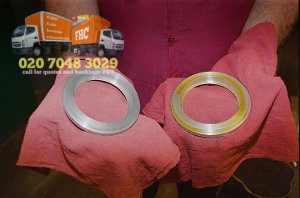The ultrasonic cleaning technology was developed in the nineteen forties and nineteen fifties, though back then it was used purely for industrial purposes. First domestic use of ultrasonic cleaning technology was in the nineteen seventies when Finnish engineering companies developed ultrasonic cleaning appliances for household use.
Ultrasonic cleaning uses some basic principles of physics in combination with some chemistry. The main system component is ultrasound. Ultrasound waves of specific frequency, typically twenty to four hundred kilohertz create the vibrations which do the cleaning. The cleaning process itself is a combination of ultrasound waves and application of cleaning solvent/agent. The ultrasound emitter machine is attached to a special container similar to a tray or tub – depending on the size of the setup. The container is filled with the particular cleaning agent chosen for the job. Ultrasound waves passing through the cleaner create a vast amount of miniature bubbles around the objects being cleaned. The bubbles collapse quickly after forming which creates a mini implosion of sorts. The implosion of the bubbles creates a mechanical scrubbing effect which removes soiling and grime from items being cleaned. Combining the mechanical scrubbing effect created by the bubbles with the cleaning properties of the detergent or solvent makes the ultrasonic cleaning process more efficient. Water could be used just as well instead of cleaning agents, though this might make the cleaning process longer and less effective. Generally, smaller scale ultrasonic cleaning procedures take about three to six minutes to yield the required results, but sometimes cleaning can take up to twenty minutes.
 Small size ultrasonic cleaners are used for finer applications such as cleaning jewellery, optical equipment like lenses, coins, antiques, dental and surgical tools as well as many more. At the moment, the recycling industry is also turning its attention to the benefits of ultrasonic cleaning technology. These cleaning systems are used in a number of hi-tech waste management facilities across Europe and North America. Ultrasonic cleaning can be used to remove dirt, grime and residue from certain types of industrial and household waste such as metal or plastic in order to purify the recycled material at the end of the process. A cleaner input of recyclables will yield cleaner output of recyclates. In the Netherlands, ultrasonic cleaning technology is used for removal of residue from refinery pipework components.
Small size ultrasonic cleaners are used for finer applications such as cleaning jewellery, optical equipment like lenses, coins, antiques, dental and surgical tools as well as many more. At the moment, the recycling industry is also turning its attention to the benefits of ultrasonic cleaning technology. These cleaning systems are used in a number of hi-tech waste management facilities across Europe and North America. Ultrasonic cleaning can be used to remove dirt, grime and residue from certain types of industrial and household waste such as metal or plastic in order to purify the recycled material at the end of the process. A cleaner input of recyclables will yield cleaner output of recyclates. In the Netherlands, ultrasonic cleaning technology is used for removal of residue from refinery pipework components.
It must be noted though, that ultrasound cleaning creates hazardous waste which must be managed accordingly. At the end of the process, the cleaning chemicals used by the system are contaminated and must be removed and disposed of. This is perhaps one of the reasons why not many companies are equipped with such systems. If you have hazardous waste at home or at your workplace, it is best to use a specialised rubbish removal service provided by a licensed and qualified provider as hazardous waste removal and disposal is subject to specific regulations. It is expected for ultrasonic cleaning technology to gain a much wider use in upcoming years.



